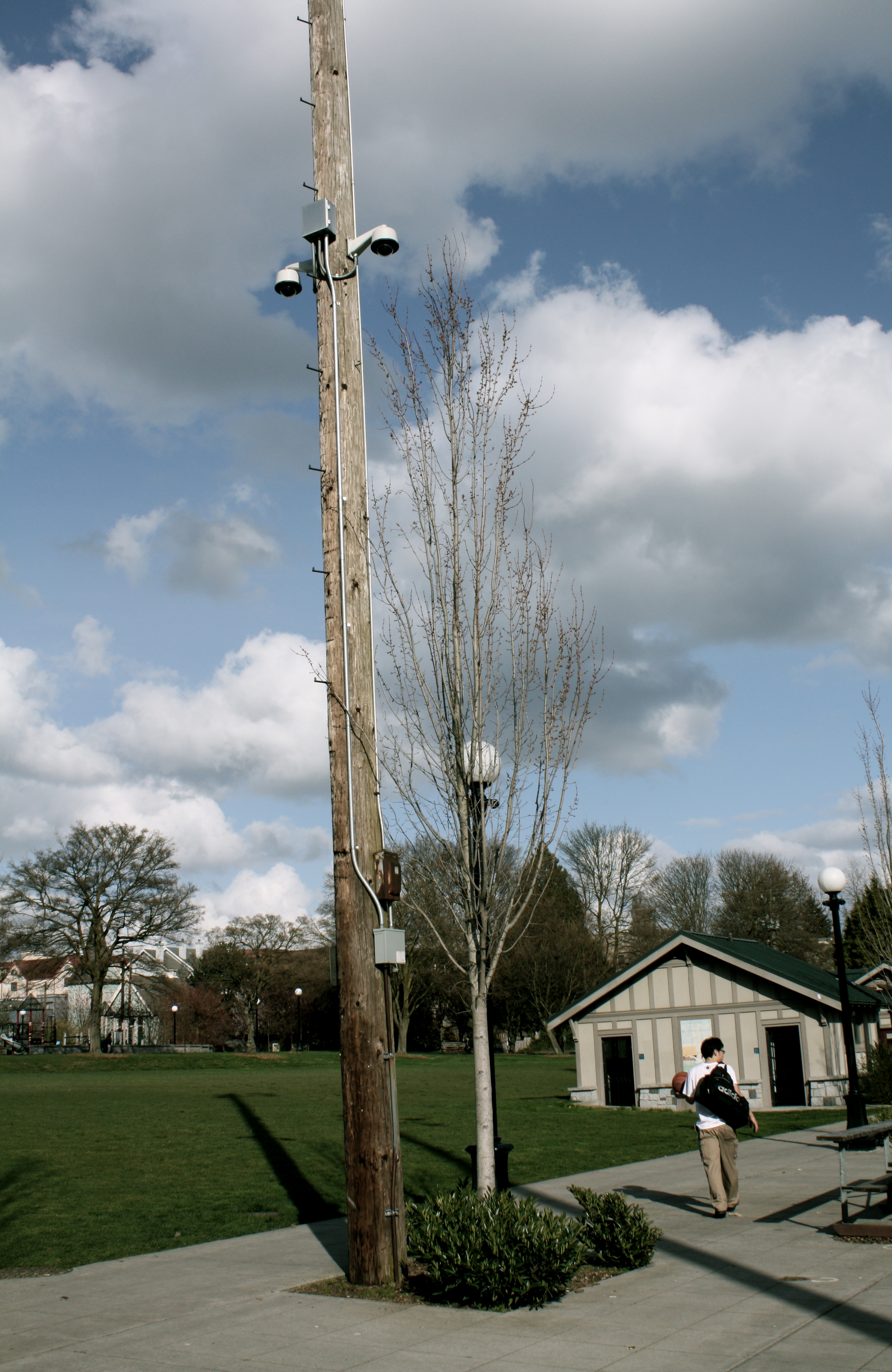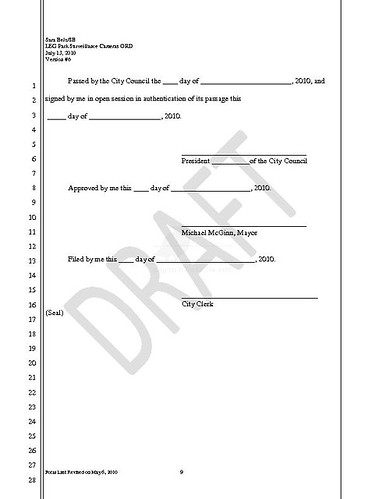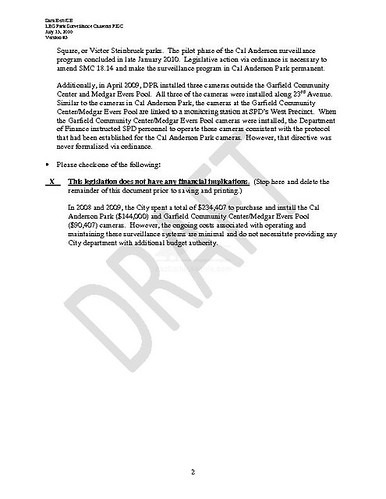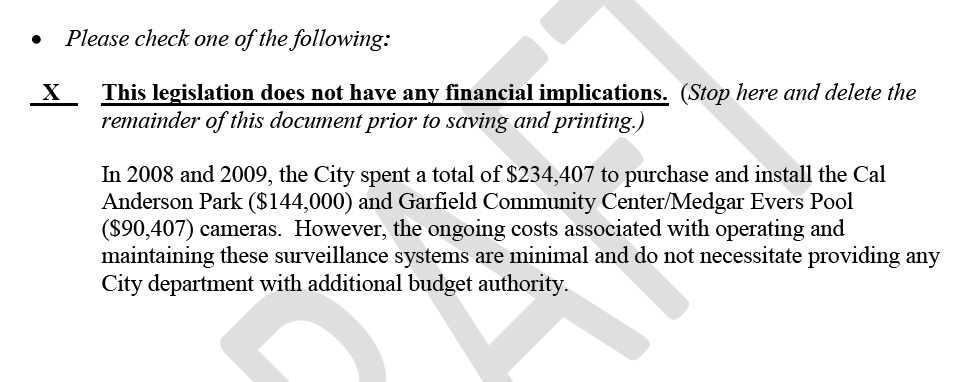UPDATE 7/15/2010 11:30 AM:
“Can they just be turned off?”
Council member Tom Rasmussen’s question captured the mood at Thursday morning’s parks committee meeting discussion of the proposed plan to continue the surveillance program responsible for the cameras in Cal Anderson Park. The draft ordinance detailed below laid out a solution to continue operating the cameras in the park and outside the Garfield Community Center.
But in Thursday’s meeting, even chair Sally Baghsaw agreed that she was not comfortable with a draft plan that would enable SPD to utilize the cameras even though the Council had never authorized their installation in the first place.
“I’ve just never been comfortable with this because I think it’s wrong to single out just one park,” Bagshaw said as she directed city staff to re-draft the legislation to include a framework for how the purchased cameras could be removed from their current locations and put to use in other areas of the city.
City staff at the meeting said it would cost a few thousand dollars to remove the cameras but a bigger sticking point would be the required legislation. Bagshaw’s direction calls for a new ordinance that outlines a process for the city to approve placement of the three cams and how they will be utilized by SPD.
Rasmussen said it would be wrong to enable the “strategy” that had put the cameras into place. “Once they’re in, who’s going to take them out?” he asked rhetorically.
Bagshaw, who said that she had been uncomfortable with moving the plan to continue the cams forward, said she would enlist the help of the ACLU and Capitol Hill resident and privacy advocate Phil Mocek in working on the new draft ordinance.
Original Report:
With the community mostly muted and City Council staffers convinced by arguments from the Seattle Police Department, large Hill institutions like Seattle U. and some local business interests that the technology is an important component of public safety, Council parks committee head Sally Bagshaw has unveiled her plan to continue the City of Seattle’s surveillance program which will now include the three cameras outside the Garfield Community Center as well as the three monitoring Cal Anderson Park.
 According to a memo summarizing the proposed legislation, the camera program would transition to a process managed across three different departments of City Hall.
According to a memo summarizing the proposed legislation, the camera program would transition to a process managed across three different departments of City Hall.
The Department of Information Technology (DoIT) would take on ownership and maintenance of the cameras, SPD would be responsible for their operation and Parks would be tasked with the long-term duty of managing the recorded video footage. SPD will also be responsible for logging who accesses the video system for recordings or for live monitoring and, equally important, who among the SPD brass authorized the access.
The draft ordinance is to be presented at Thursday morning’s meeting of Bagshaw’s committee.
According to the memo, the earliest the legislation can be acted on is the parks committee meeting on August 5 leaving a few weeks for feedback from the community.
There might not be much more to say. A session of the parks committee held on the Hill in May to discuss the camera program drew a tiny crowd. In June, the Stranger and the ACLU failed to raise much interest when they “discovered” additional surveillance cameras operating in the Central District during a tour of the SPD facilities where the cameras are monitored. It turned out that the cameras near the Garfield Community Center had been in place since 2009 and had been reported on not once but twice by the Central District News.
A person close to the public process surrounding the camera program tells CHS that documented opposition to the surveillance is weak and that only one citizen, one civil rights organization and one community organization have gone on the record to oppose the cameras. In May, we reported statements from the ACLU and the Cal Anderson Park Alliance asking Bagshaw not to continue the program.
We have attached to this post a memo describing the ordinance, the draft ordinance itself and a document outlining the proposed program’s fiscal impact.
Here’s the bottom line from that document, by the way — the plan reportedly won’t require any additional budget to implement.
We covered the background of the controversial surveillance program here. Three cameras currently perch on poles above the visitors to Cal Anderson Park capturing video of the area around the clock but because of restrictions on how the technology can be used, nobody is watching the footage and the program and the technology has sat in limbo. As the Greg Nickels administration pilot program came to an end, Bagshaw was faced with figuring out how best to either shut the cameras down for good — or keep them rolling.
Last October, the City Auditor’s office presented its findings on the effectiveness of the cameras to deter crime and provide safety. We’ve included a copy of the report on this post. The report concluded that the cameras had not been effective at deterring criminal activity and the only documented time SPD utilized any footage was during the investigation of reports of in August 2009.
Still, SPD will be pleased with the proposal as the department has been advocating for a continuance of the program since the pilot came to a close. “We’re a fan of any kind of tool that’s available to help us solve crime,” SPD spokesperson Greg Schmidt told Bagshaw’s committee in May.
From the attached Parks Committee Memo summarizing the new ordinance:
Assigns responsibility for the ownership and use of the cameras to the following City departments:o Department of Information Technology (DoIT): Ownership and maintenance of the cameras.
o Seattle Police Department (SPD): Operation of the cameras.
o Department of Parks and Recreation (DPR): Ownership of the recorded video footage obtained by the cameras.
Requires the cameras to operate in passive mode 24 hours per day.
Limits the authority to use the cameras for live monitoring to SPD personnel.
SPD staff may engage in live monitoring under the following circumstances only:
o When SPD has a reasonable suspicion that a crime may be in progress within the area visible from an installed camera;
o To conduct investigations of suspected ongoing criminal activities occurring in areas that may be viewed by an installed camera;
o During a state of emergency declared by the Mayor; or
o For system training, testing, maintenance or repair (also applies to staff from DoIT.)
Requires City staff to maintain a log that records the date, time, and duration of all live monitoring and any recorded footage that is viewed.
Permits authorized City staff to view or duplicate recorded footage obtained by the cameras under the following circumstances only:
o To comply with the a court order, the Washington Public Records Act, discovery requirements in a legal proceeding or other applicable law;
o As part of a criminal, civil, or administrative investigation;
o To evaluate the footage for possible use in a criminal, civil or administrative legal proceeding in which the City is, or is reasonably expected to become, a party; and
o For system training, testing, maintenance or repair.
Establishes a two-week retention schedule for all recorded footage obtained by the cameras that is never viewed.
Requires DPR to notify the public about the installation of the cameras via posted signs and at least one community meeting.







It becomes apparent that Tom R. is grounded and able to speak up on issues.
Right on Tom – unplug them and move on – the city is all but out of money and there are no jobs …. downtown has historic vacancies.
Camera in the park, not important at all.
I’m fine with the cameras.
$$$$$$
are they worth it?
or just an illusion as crime fighting?
While I’m an advocate of privacy, I don’t see the surveillance cameras in parks as a privacy issue. It’s an issue of unwarranted surveillance of the public. I think my advocacy of civil liberties is more apropos to this situation.
As ACLU-WA Technology and Liberty Project Director Brian Alseth mentioned during the public comment portion of today’s meeting, the fiscal statement presented today seems to be in error. It doesn’t account for the cost of the annual audit required in the proposed legislation, camera maintenance, training for operators of the cameras, ongoing network support, or cutting down the tree branch that now blocks the view of one camera.
DoIT estimated the cost of removing the surveillance equipment from the park to be $1800. Presumably that includes the equipment in the shelter house and all the cables, since simply removing the cameras from the poles shouldn’t cost any more than changing a light bulb up there. Also according to DoIT, the cameras comply with city standards, so they can be re-deployed elsewhere.
As for whether they can simply be turned off: The law requires that they be turned off within 90 days of the end of the pilot program. Seattle Department of IT’s and Seattle Police Department’s operation of the cameras since approximately March, 2010, seems to have been (and to remain) in violation of city ordinance.
SMC 18.14.030 states:
> Additional ordinance authority is required to install cameras in
> other City parks or to operate cameras in the parks identified
> above beyond ninety days after the program evaluation described
> in SMC Section 18.14.100 is submitted to the City Council.
Another interesting exchange came toward the end of the discussion, when someone asked who installed the mysterious cameras near Garfield High (those that we discovered when touring the 9-1-1 Operations Center a few weeks ago): Parks? Police? SDOT? Greg Schmidt from SPD said, “Not police.” Christopher Williams: “I think we used a contractor.” Rasmussen: “And who directed that installation?” Williams: “Uh, that was Deputy Mayor Tim Ceis.” Tom Rasmussen said that installation of cameras should not be done at the direction of one person, whether that be the Mayor, or City Council, or Parks. Sally Bagshaw said she agreed.
Thanks to City Council members Sally Bagshaw, Bruce Harrell, and Tom Rasmussen, for making the sensible choice today to have the cameras removed. We gave it a shot, and found that they weren’t useful. This is the logical conclusion.